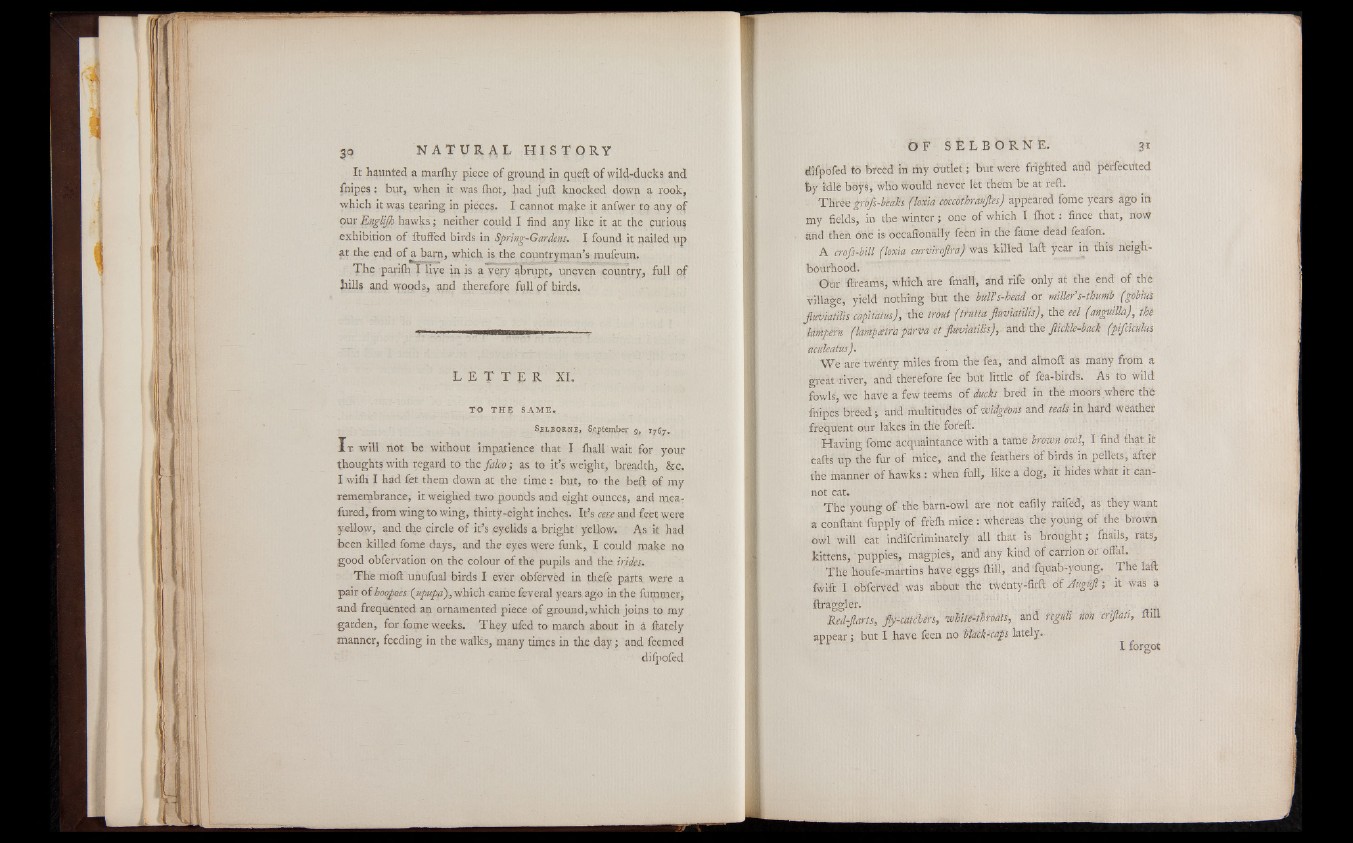
It haunted a marfhy piece of ground in quell of wild-ducks and
fnipes : but, when it was (hot, had juft knocked down a rook,
which it was tearing in pieces. I cannot make it anfwer to any of
our Englijh hawks; neither could I find any like it at the curious
exhibition of fluffed birds in Spring-Gardens. I found it nailed up
at the end of a barn, which is the countryman’s mufeutn.
The parilh I liye in is a very abrupt, uneven country, full of
hills and woods, and therefore full of birds.
l e t t e r XI.
TO THE SAME,.
Selborne, September 9, 17^7.
I t will not be without impatience that I ftjall wait for your
thoughts with regard to the falco; as to it’s weight, breadth, &c,
I wifh I had fet them down at the time : but, to the beft of my
remembrance, it weighed two pounds and eight ounces, and ntea-
•fured, from wing to wing, thirty-eight inches. Ilfs.cm and feet were
yellow, and the circle of it’s eyelids a bright yellow. As i,t had
been killed fome days, and the eyes were funk, I could make no
good obfervation on the colour of the pupils and the tricks...
The moll unufual birds I ever obferved in tb.efe parts were a
pair of hoopoes (upitpd)., which came feveral years ago in the fummer,
and frequented an ornamented piece of ground, which joins to my
garden, for fome weeks. They ufed to march about in a flately
manner, feeding in the walks, many times in the day; and feerned
difpofed
difpofed tö twééd in my outlet; but were frighted and pèrfecvfted
by idle boys, who would never let them be at reft.
Three grtfs-bedks (loxia corcotkrauftes) appeared fome years ago in
my fields, in the winter; one of which I fo o t: fince that, no#
and then one is1 dccafi'onally feèri in the fame dead feafon.
A erofs-bill (loxia curi'irofira) was killed laft year in this neighbourhood.
Oar ftreams, which are final!, and rife only at the end of thé
village, yield nothing but the bull’s-head or. miller’s-thuntb (gobiu's
jlwvratilis cnpitatus), the trout (tratta jlüviatilis), thé eel (anguilla), thé
lampern (lamptetrafdrva et jheviatilis),- arid the JUckle-back (pifciculus
aculeatus).
"We are twenty miles from the fea, arid almoff as mariy from a
great river, and therefore fee but little of féa-birds. As to wild
fowls, we have a few teems of ducks bred in the moors where thé
fnipes brééd; and multitudes of widgeons and teals in hard weather
frequent our lakes in the foreft.
Having fome acquaintance with a tame bfown bWl, I find that it
calls up the fur of mice, and the feathers of birds in pellets, after
the manner of hawks: when full, like a dog, it hides what it cannot
eat.
The young of the barn-owl are not eafily raifed, as they want
a conftarit fupply of frelh mice: Whereas, the young of the brown
owl will eat indifcrimihately all that is brought; fnails, rats,
kittens,‘puppies? magpies, and any kiöd óf carrion or öffal.
The houfe-martins have eggs Hill, arid Tquab-young. The laft
fwift I obferved . was about the twénty-firft ó i JugUfl; it Was a
ftraggler. ' . . .
Red-Jlarts, fiy-üttchérs, white-throats, and regttli iloti crijlati, ftill
appear; but I have feen no Mack-caps lately,
M I forgot